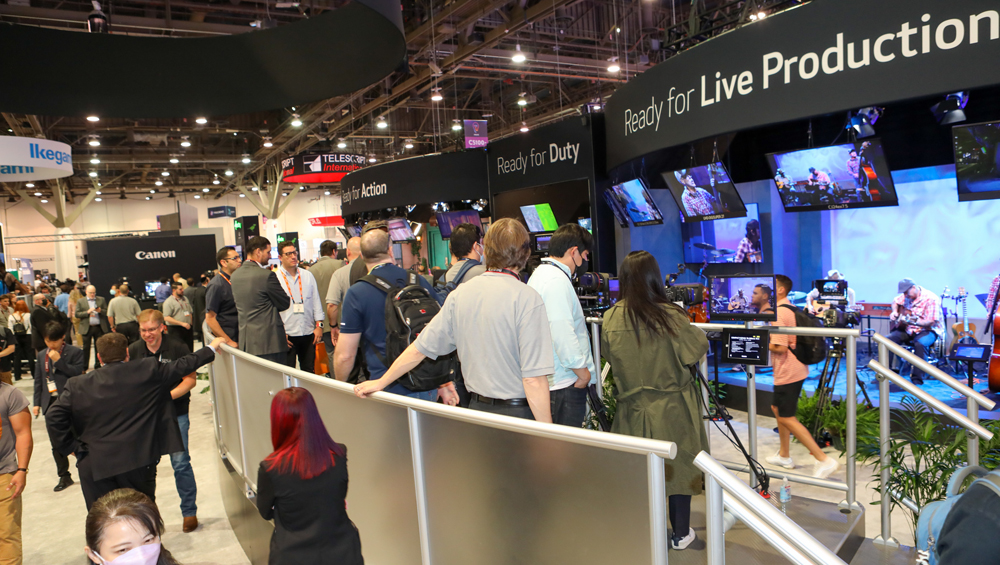
Cloud And IP Tech Dominate NAB Show Floor

Many conversations at the NAB Show revolved around the cloud, IP and hybrid environments, with vendors promoting solutions geared toward those topics.
Vendors at this year’s NAB – the first trade show that many in the industry have attended in person since the COVID-19 pandemic began – featured a number of improved technologies that broadcasters rushed to use in the face of social distancing requirements as well as tools aimed at helping broadcasters on their journey toward creating IP environments.
At the same time, vendors also demonstrated next-gen products that could help save time and virtual technologies that could help usher the industry into the future of broadcast.
Neal Manowitz, president and COO of Sony Electronics, said the last three years have seen a shift toward remote production workflows, virtual production and the increased use of cinematic cameras by broadcasters.
“The global pandemic has acted as an accelerant for progress,” he said.
And part of that progress has been the uptake of remote operations.
The need to “connect all the great talent” in remote and collaborative workflows has led to improvements and added features in existing products, said Blackmagic Design President Dan May.
One is Blackmagic’s DaVinci Resolve 18, released in mid-April, which allows multiple people to simultaneously work on the same project. Resolve 18 is currently in beta, May said.
The cloud is a major facilitator of remote work, but transferring large video files presents its own issue.
As far as Steve Wind Mozley, Vizrt CMO, is concerned, providing services and products that work in the cloud is basic table stakes.
“The cloud is super important,” he said. “But it’s what you use that cloud to do that’s important.”
And NDI is the “glue” that makes cloud-based technology possible, said Vizrt Head of Branding Content Chris Black.
One of the problems the broadcast industry faces is intelligent file transfer, said Signiant CMO Jonathan Finegold.
Over the years, files have gotten larger, particularly related to the increased number of cameras used at events and the higher amount of resolution used for videos, he said.
“The amount of data is just insane,” he said.
And it’s complicated by the fact that remote work remains quite common as the pandemic enters its third year. At the same time, content is traveling around the world, and companies are prioritizing security around files, he said.
Broadcasters are experimenting with the cloud, he said, “and with the amount of data” they are moving. And the storage landscape has become increasingly complex with storage happening on-prem, in private clouds and through various vendors.
With those factors in mind, Finegold said, Signiant offers broadcasters simpler solutions for file transfer that “simplifies that chaos and complexity” to provide lightweight and simple transfer.
And while cloud is a major topic, so is the transition to IP workflows.
But “IP’s not for everyone,” Mo Goyal, senior director international business development at Evertz, said during a press event. “SDI’s not going to disappear any time soon.”
There are several reasons for this, including cost of ownership and the fact that some organizations don’t “see themselves getting to the scale that IP benefits them,” Goyal says.
As such, Evertz is working to help those customers futureproof their facilities with equipment like the new NEXX 12G-SDI Core Router, which supports SMPTE 2110 gateway functions, he says.
On the other hand, for those interested in working in an IP environment, companies like Lawo are working to make it easier for broadcasters to transition from SDI to IP based workflows. Andreas Hilmer, Lawo CMO, said the company’s new .edge device is designed to handle high density conversion of SDI to IP.
“It’s designed as an edge device for IP infrastructure, but moreover, it’s designed as an easy replacement for existing SDI routers,” he said.
In short, he said, replacing a router with Lawo’s .edge device can help a broadcaster “become an IP facility.”
IP and cloud aside, visual storytelling elements like graphics were also an important part of the conversation at NAB.
For example, Vizrt was talking up adaptive graphics capabilities as a feature in Viz Engine 5.
According to Vizrt CTO Gerhard Lang, the graphics can adapt to the requirements of the output device.
Instead of multiple graphics adjusted for different formats, “the graphics adapt themselves to the parameterization,” he said. “Instead of doing things three times, you do it once” while the graphics adapt to save time and reduce the potential for errors.
And Brainstorm is working to support real-time immersive reality, said Miguel Churruca, marketing and communications director.
“We are focusing on real-time 3D graphics, and we are expanding the reach of our solutions to become more extended-reality-oriented,” he said.
Rendering, preparing and setting up such graphics takes time and effort, he said.
“We’re mixing LED-based expanded-reality with virtual chroma key sets,” he said. “We’re mixing them in the same demo.”
And the result is endless possibility, he said.
“You can do whatever you want inside there. Any small set with a chromo set or an LED wall can become a huge set or a full environment with graphics coming in,” Churruca said.
Finally, vendors are building technologies for the virtual world, too. Veritone, for instance, launched Veriverse in April to provide solutions that are metaverse-ready or metaverse-enabled.
Currently, Ashley Bailey, Veritone’s director of product marketing for synthetics and metaverse, said, most broadcasters are still in the information-gathering stage when it comes to the metaverse, but Veritone wants to have the solutions they need ready when they are needed.
But when it comes to the metaverse, she said, broadcasters “know they need to do something, but not everyone is clear on what.”
































Comments (0)